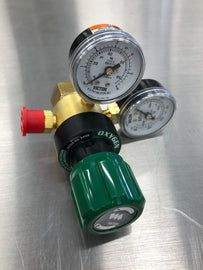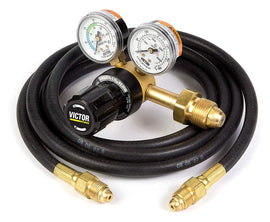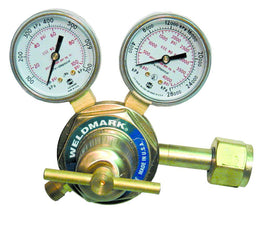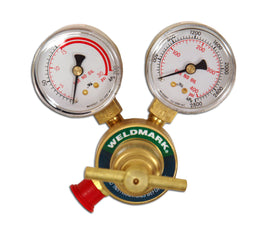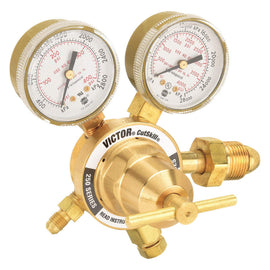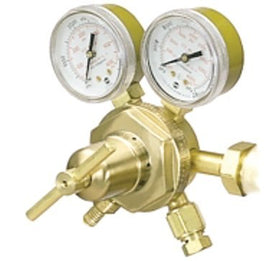While all regulators can reduce pressure in a gas system, CONCOA high purity regulators conform to very exacting standards of pressure control. Below, we discuss some basis of comparison that can help you navigate this catalog and choose a regulator that best suits your needs. Of course, our Customer Service representatives would be happy to answer any further questions you may have about regulator design and operation.
Single Stage vs. Dual Stage
Single stage regulators reduce pressure in a single step to deliver a pressure within a specific range. Regulators designed in this way will show a slight variation in delivery pressure as the cylinder pressure falls during use. For this reason, single stage regulators are best suited for applications where a constant outlet pressure is not critical, where an operator can monitor and readjust pressure, or where inlet pressure is constant. Dual stage regulators perform the same function as single stage regulators. However, delivery pressure remains constant as cylinder pressure decreases, and greater accuracy in pressure control is maintained because the pressure reduction is performed in two steps. Dual stage regulators are recommended for applications requiring a constant outlet pressure over the life of a gas cylinder.
Helium Leak Integrity
Helium Leak integrity is a measurement of how well a regulator prevents gases from leaking into or out of a regulator body. The measured quantity is expressed as a flow rate such as 1 x 10-9 scc/sec He (1 billionth of a cc/sec). In this case, a Helium Leak integrity rating of 1 x 10-9 would indicate that the regulator would leak enough gas to fill one cubic centimeter every 33 years. If the rating were 1 x 10‑3, the regulator would leak enough gas to fill one cubic centimeter in just 17 minutes. Helium is used as the test gas because it is chemically inert, it is easy to detect, and it is an extremely small molecule with the ability to pass through the smallest leak. The lower the Helium Leak specification, the better the regulator will be at preventing leaks into the atmosphere and at minimizing contamination from gases outside the body.
Materials of Construction
The materials of construction for a regulator should be selected based on the properties and purity of the gas being used. CONCOA manufactures regulators from brass, aluminum, and 316L stainless steel. Brass is compatible with most of the non-reactive gases. A choice of forged body or barstock construction is available. Forged body regulators are economical; however, their internal surface finishes are relatively rough as compared to barstock body regulators. Barstock body regulators have all wetted surfaces machined to a smooth finish, which reduces the possibility of contamination. 316L stainless steel is highly corrosion resistant and is suitable for use with many of the highly corrosive gases in their anhydrous form. Aluminum is an economical lightweight alternative to stainless steel for many of the mildly corrosive gases. Refer to the compatibility charts on pages 199-201 or consult your gas supplier to determine suitable materials of construction.
Cylinder Connections
CONCOA manufactures cylinder connections which conform to all worldwide standards. In the US, the Compressed Gas Association (CGA) has designated specific cylinder connections for each gas service and pressure rating. Refer to CGA publication V-1 for more information. A few of the international standards CONCOA provides include DIN 477, BS 341, JIS (Japan), and AS (Australia). Please note that a CGA connection limits the temperature range of a regulator to the guidelines of the connection.
Flow Charts
The flow charts found on pages 202-208 are a graphical representation of test results which show the change in outlet pressure. To use the chart, determine the maximum no-flow pressure permitted by your system. Locate this pressure on the vertical axis of the chart. If there is no curve for your specific condition, interpolate a curve. Follow the curve to the desired flow rate on the horizontal scale. Read horizontally to the left to determine the corresponding pressure drop. Because flow rate is dependent upon inlet pressure, data is presented at full cylinder pressure 2000 PSIG (137 BAR), partially full 500 PSIG (34 BAR), and nearly empty 200 PSIG (14 BAR).
Diaphragms
The diaphragm is a sensing element crucial to the function of the regulator and the purity of gas delivery. Stainless steel diaphragms are corrosion resistant and have low leakage rate characteristics. Neoprene diaphragms may offer more sensitive pressure control but do not offer the gas purity of stainless steel. Coating a neoprene diaphragm with PCTFE enhances gas purity greatly.
Specific Applications
While a single or dual stage regulator of the appropriate material will suffice in most gas services, some applications require specially designed regulators. For example, within the 400 Series, the 455 Series regulators are specifically designed for use with highly corrosive gases, while the 492 Series regulators can safely deliver gas at extremely high pressures. Regulators with SilcoNert™ 1020 such as the 420 Series, 430 Series and the 515 Series are ideal for low sulfur application standards and calibration. If you are unsure about your requirements, please contact CONCOA for assistance.
All rights to CONCOA & CONCOA.com

